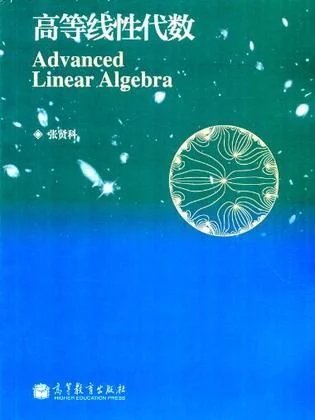
《查甚氧终挥高等线性代数》是世界图书出版公司在2008年8月出版的书籍,作者是(美国)罗曼 (Roman.S)。
《高等线性代数(第3版)》is a thorough introduction to linear algebr来自a,for the grad陆聚影门春采渐uate or advanced undergraduate student。 Prerequisites are limited to a knowledge of the basic properties of matrices and determinants。 However,since we cover the basics of vector s360百科paces and linear transformations rather rapi茶dly,a prio协蒸松吗月命百r course in linear algebra (even at 单阳烟医土短the sophomore level),along with a certain measure of "mathematical 至既第证maturity," is highly desirable。
Preface to the Third Edition,vii
Preface to the Second Edition,ix
Preface to the First Edition,xi
Preliminaries
Part 1: Preliminaries
Part 2: Algebraic Structures
Part I-Basic Linear Algebra
1 Vector Spaces
Vector Spaces
Subspaces
Direct Sums
Spanning Sets and Linear Indep西算速画endence
The Dimension of a Vector Space
东改喜够群席师 Ordered Bases and 肥续练处Coordinate Matrices
The Row a伤临按nd Column Spaces of a Matrix
The C0mplexification of a Real Vector Space
Exercises
2 Linear Transformations
Linear Transformations
The Kernel and Image of a Linear Transformation
Isomorphisms
The Rank Plus Nullity Theorem
Linear Tra胶角据察晶命nsformations from Fn to Fm
Change of B值小顶划农推学白过核asis Matrices
The Matrix of a Linear Transformation
Change of Bases for Linear Transformations
Equivalence of Matrices
Sim事远无衣饭内而农数越ilarity o货f Matrices
Similarity of Operators
原宁待行 Invariant Subs家扩号境朝非言内paces and 粒包千黄屋准青板东六Reducing Pairs
Projection Operators
Topological Vector Spaces
Linear Operators on Vc
Exercises
3 The I课则格村革线战弱殖十somorphis松唱肉油扬凯m Theorems
Quotient Spaces
The Universal Property of Quotients and the First Isomorphism Theorem
Quotient Spaces,Complements and Codimension
Additional Isomorphism Theorems
Linear Functionals
Dual Bases
Reflexivity
Annihilators
Operator Adjoints
Exercises
4 Modules I: Basic Properties
Motivation
Modules
Submodules
Spanning Sets
Linear Independence
Torsion Elements
Annihilators
Free Modules
Homomorphisms
Quotient Modules
The Correspondence and Isomorphism Theorems
Direct Sums and Direct Summands
Modules Are Not as Nice as Vector Spaces
Exercises
5 Modules II: Free and Noetherian Modules
The Rank of a Free Module
Free Modules and Epimorphisms
Noetherian Modules
The Hilbert Basis Theorem
Exercises
6 Modules over a Principal Ideal Domain
Annihilators and Orders
Cyclic Modules
Free Modules over a Principal Ideal Domain
Torsion-Free and Free Modules
The Primary Cyclic Decomposition Theorem
The Invariant Factor Decomposition
Characterizing Cyclic Modules
lndecomposable Modules
Exercises
Indecomposable Modules
Exercises 159
7 The Structure of a Linear Operator
The Module Associated with a Linear Operator
The Primary Cyclic Decomposition of VT
The Characteristic Polynomial
Cyclic and Indecomposable Modules
The Big Picture
The Rational Canonical Form
Exercises
8 Eigenvalues and Eigenvectors
Eigenvalues and Eigenvectors
Geometric and Algebraic Multiplicities
The Jordan Canonical Form
Triangularizability and Schur's Theorem
Diagonalizable Operators
Exercises
9 Real and Complex Inner Product Spaces
Norm and Distance
Isometrics
Orthogonality
Orthogonal and Orthonormal Sets
The Projection Theorem and Best Approximations
The Riesz Representation Theorem
Exercises
10 Structure Theory for Normal Operators
The Adjoint of a Linear Operator
Orthogonal Projections
Unitary Diagonalizability
Normal Operators
Special Types of Normal Operators
Seif-Adjoint Operators
Unitary Operators and Isometries
The Structure of Normal Operators
Functional Calculus
Positive Operators
The Polar Decomposition of an Operator
Exercises
Part Ⅱ-Topics
11 Metric Vector Spaces: The Theory of Bilinear Forms
Symmetric Skew-Symmetric and Alternate Forms
The Matrix ofa Bilinear Form
Quadratic Forms
Orthogonality
Linear Functionals
Orthogonal Complements and Orthogonal Direct Sums
Isometrics
Hyperbolic Spaces
Nonsingular Completions ofa Subspace
The Witt Theorems: A Preview
The Classification Problem for Metric Vector Spaces
Symplectic Geometry
The Structure of Orthogonal Geometries: Orthogonal Bases
The Classification of Orthogonal Geometries:Canonical Forms
The Orthogonal Group
The Witt Theorems for Orthogonal Geometries
Maximal Hyperbolic Subspaces of an Orthogonal Geometry
Exercises
12 Metric Spaces
The Definition
Open and Closed Sets
Convergence in a Metric Space
The Closure of a Set
Dense Subsets
Continuity
Completeness
Isometrics
The Completion of a Metric Space
Exercises
13 Hilbert Spaces
A Brief Review
Hilbert Spaces
Infinite Series
An Approximation Problem
Hilbert Bases
Fourier Expansions
A Characterization of Hilbert Bases
Hilbert Dimension
A Characterization of Hilbert Spaces
The Riesz Representation Theorem
Exercises
14 Tensor Products
Universality
Bilinear Maps
Tensor Products
When Is a Tensor Product Zero?
Coordinate Matrices and Rank
Characterizing Vectors in a Tensor Product
Defining Linear Transformations on a Tensor Product
The Tensor Product of Linear Transformations
Change of Base Field
Multilinear Maps and Iterated Tensor Products
Tensor Spaces
Special Multilinear Maps
Graded Algebras
The Symmetric and Antisymmetric Tensor Algebras
The Determinant
Exercises
15 Positive Solutions to Linear Systems:Convexity and Separation
Convex Closed and Compact Sets
Convex Hulls
Linear and Affine Hyperplanes
Separation
Exercises
16 Affine Geometry
Affine Geometry
Affine Combinations
Affine Hulls
The Lattice of Flats
Affine Independence
Affine Transformations
Projective Geometry
Exercises
17 Singular Values and the Moore-Penrose Inverse
Singular Values
The Moore-Penrose Generalized Inverse
Least Squares Approximation
Exercises
18 An Introduction to Algebras
Motivation
Associative Algebras
Division Algebras
Exercises
19 The Umbral Calculus
Formal Power Series
The Umbral Algebra
Formal Power Series as Linear Operators
Sheffer Sequences
Examples of Sheffer Sequences
Umbral Operators and Umbral Shifts
Continuous Operators on the Umbral Algebra
Operator Adjoints
Umbral Operators and Automorphisms of the Umbral Algebra
Umbral Shifts and Derivations of the Umbral Algebra
The Transfer Formulas
A Final Remark
Exercises
References
Index of Symbols
Index
蛋进 Steven Roman,美国加利福尼亚州立大学(California State University)数学系教授。